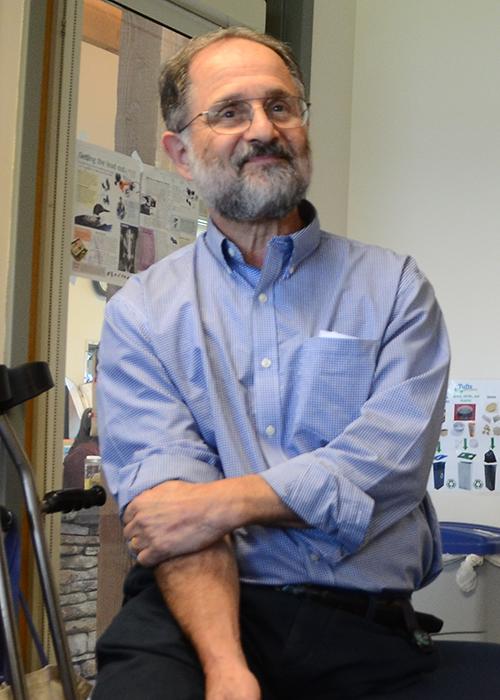-
About
- Leadership & Faculty
- News & Events
-
Academics
- Graduate
- Advanced Clinical Training
- Continuing Education
- Academic Departments
- Academic Offices
- Simulation Experiences
-
Student Life
- Offices
-
Research
-
Hospitals & Clinics
- Emergency Care
- Hospital Services
-
Community Outreach
- Volunteer
Research/Areas of Interest
- Functional and surgical anatomy of birds and reptiles.
- Environmental pathology (including toxicology) of wildlife species.
- Captive management of aquatic reptiles, birds and mammals.
- Allometric scaling as a tool for understanding comparative clinical medicine.
- Development of minimally invasive field techniques for wildlife health studies.
Selected Research Projects:
- Lead (Pb) toxicosis in wildlife and public health.
- Seanet — threats to aquatic birds.
- WebAtlas of Wildlife Anatomy & Pathology.
- Surveys of vernal pools and other campus resources.
- Presence of antibiotic resistant organisms in native wildlife.
Education
Residency, Zoo & Wildlife Medicine - 1985 - 1988
D.V.M., Cummings School of Veterinary Medicine at Tufts University, 1984
B.S., Cornell University, 1971
Biography
Mark Pokras is one of the old timers at the clinic, having been a veterinary student at tufts from 1980-84, a resident in zoo and wildlife medicine (under Dr. Charles Sedgwick, the Clinic’s first director) from 1985-87, a faculty member since 1988, and Clinic Director from 1995 – 2008. Mark is also one of the founders of Tufts TCCM. Mark grew up in New York, New Jersey, New England, Mexico and Venezuela, and did his undergraduate work at Cornell University. Next he (and wife Martha) worked in marine biological research from 1971-1974, and then taught ornithology and marine biology at Stockton State College in New Jersey until Mark entered Cummings School of Veterinary Medicine at Tufts University. He regularly consults for a variety of private, state and federal wildlife and environmental agencies on issues of environmental health and policy. Mark’s professional interests include working with students, medicine and surgery of native wildlife (especially birds and reptiles), aquatic birds and environmental health, allometric scaling and conservation biology. He has been doing mortality research on loons since 1987 and is widely recognized for his work on lead poisoning. Mark enjoys spending time with his wife and two daughters, a variety of outdoor activities, and playing music.
Additional Information
Other Campus Activities
- Sponsor a variety of student projects & selectives.
- Host “Open Mike” nights on campus.
- Advise student WAZE group (Wildlife, Aquatics, Zoo & Exotics).
- Lead campus & regional nature walks.
Selected Publications and Presentations
- Pokras, MA and MR Kneeland. 2009. Understanding Lead Uptake and Effects across Species Lines: A Conservation Medicine Based Approach. InRT Watson, M Fuller, M Pokras, and WG Hunt, (eds.). Ingestion of lead from spent ammunition: Implications for wildlife and humans. The Peregrine Fund, Boise, Idaho, USA. ISBN: 0961983957.
- Fiorello, CV, Nisbet, ICT, Hatch, JJ, Corsiglia, C and MA Pokras. 2009. Hematology and absence of hemoparasites in breeding common terns from Cape Cod, Massachusetts. J. Zoo and Wildlife Med. 40(3): 409-413.
- Pokras, MA and MR Kneeland. 2008. Lead poisoning: using transdisciplinary approaches to solve an ancient problem. EcoHealth. 5(3): 379-385.
- Bogomolni A, Ellis J, Gast B, Harris R, Pokras M, Touhey K, Moore M. 2006. Emerging zoonoses in marine mammals and seabirds of the northeast U.S. Oceans ’06 MTS/IEEE-Boston, Massachusetts. ISBN: 1-4244-0115-1.: 9pp
- Haefele, HJ, Sidor, I, Evers, DC, Hoyt, DE and MA Pokras. 2005. Hematologic and physiologic reference ranges for free-living adult and young common loons. J. Zoo and Wildlife Med. 36:385-390.
- Pierce, KE, Harris, RJ, Larned, LS and MA Pokras. 2004. Obstruction and starvation associated with plastic ingestion in a northern gannet (Sula bassanus) and a greater shearwater (Puffinus gravis). Marine Ornith. 32:185-187.
- Sidor,IF, Pokras, MA, Major, AR, Poppenga, R, and RM Miconi. 2003. Mortality of the common loon in New England, 1988 to 1999. J. of Wildlife Disease. 39(2):306-315.
- Modrall, J.D., Wheeler, T., Pokras, M. and L. M. Romero. 2001. The impact of veterinary administration of antibiotics on the bacterial ecology of wild bird populations. American Zoologist. 41(6): 1528- 1529.
- Pokras, MA, Tabor, G, Pearl,M, Sherman, D, and P Epstein. 2000. Conservation medicine: an emerging field. In: Nature and human society: the quest for a sustainable world. National Academy Press. Washington, DC. pp: 551-556.
- Burger, J. Pokras, M.A. Chafel, R. and M. Gochfeld. 1994. Heavy metal concentrations in feathers of common loons Gavia immer in the Northeastern United States and age differences in mercury levels. Envir.Monit. and Assessment 30:1-7.
- Pokras,M.A., Zeman, A, Kirkwood,J. and C.J.Sedgwick. 1993. An introduction to allometric scaling and its uses in raptor medicine. In Redig, PT et al.(eds).Raptor biomedicine. Univ. of Minnesota Press. pp: 211-224.
